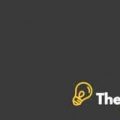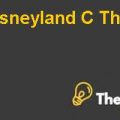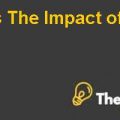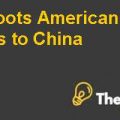FANUC Corporation: Reassessing the firm's governance and financial policies Case Study Analysis
Key assumptions
The key assumptions for the quantitative analysis i.e. the calculation of the organization’s net present value was carried out in two steps i.e. before debt and after debt. The overall assumption for the analysis included debt – 21 percent, equity – 79 percent, and cost of debt - 9 percent.The tax rate was taken from the projections given in the Exhibit 4 of the case, for the year 2019 i.e. 32.4 percent. Similarly, the payout ratio was considered as 30 percent,because it is kept constant throughout the projection from the year 2015-2019. Additionally,the reason behind keeping the payout ratioconstant was to maintain the interest of investors and shareholders. Furthermore, the growth rate was considered to be 2 percent,based on an increase in economic growth expected by the implementation of growth strategy in Japan.
Before Debt:
As the organization operated at 100 percent equity and zero debt;the return on equity of the organization was considered to be 8.6%. In order to have efficiency in the capital structure and to experience profitable growth; all the organizations in Japan were recommended to keep the return of equity to a minimum 8 percent, according to the report issued by Ministry of Economy, Trade and Industry. Thus, the calculated terminal value was ¥ 2187 billion. Similarly, the total discounted cash flows or net present value of FANUC with zero debt, was calculated to be ¥ 2148.61 Billion, as shown in Exhibit C.
After Debt:
For WACC calculation;the cost of debt, return on equity, and tax rate were taken from the projections of 2019, in Exhibit 4. Whereas, the weight of equity was calculated by subtracting the weight of debt with 1 i.e. 79.0 percent. Similarly, debt rate after tax was calculated by multiplyingcost of debt with 1 – tax rate i.e. 6.1 percent. Thus, the WACC calculated was 8.1 percent i.e. 0.5 percent less than the WACC before debt. The calculated terminal value at the growth rate of 2 percent, was ¥1748 Billion. Additionally, the total discounted cash flows or net present value of FANUC with 21 percent debt was calculated as ¥1842.04 Billion, as shown in Exhibit D.
Recommendation:
Based on the analysis of the financial as well as the governance policies of the organization;the organization is recommended notto bring any change in its financial and governance policy. Although it has been recommended by the growth strategy of Japan, that all the organizations must include two external directors i.e. the composition of board of directors,but, it would turn out to be an insignificant approach in terms of the governance policy of FANUC, because it is more focused on keeping its financial information confidential, which allows the organization to keep its strategic approach and plans out of its competitors’ sight. The inclusion of two outsiders increase the probability of the company’s information to be leaked in the market, which might become harmful for the organization’s future growth and its vision.
Considering the organization’s financial performance of the organization, none of the changes are recommended for the organization to introduce, because the enterprise value of FANUC is more with zero debt, which is associated withthe existing policy as compared to the change in policy. The probability of decreased enterprise value by taking debt, would not only influence the interest of investor and shareholders but would also end up declining the accumulated cash in the balance sheet. Thus, treasury shares policy should also remain untouched.
But, the return on equity should be kept 8.6 percent,because it represents a significant NPV. Also, the department for shareholders’ relation, must be created as it would provide better insight to the organization and theinvestors, to have an improved communication. This would result in an effective decision making process. However, it is completely dependent on the management to consider the strategic approaches or options suggested for the organization’s benefit. (Pindyck, 1995 )
Conclusion
FANUC has represented a significant growth history, since its establishment and the founder of the organization has invested most of his time in the organization’s management. Theevaluation of the financial and governance policies were found to be appropriate, and did not require any major changes. Introducing new policies in the organization would last a negative influence over itscapital structure. However, the current capital structure is referred to as illogical. Thus, continuing the business operations with the existing strategic approach,seems much beneficial for the long-term survival of the organization.....................................
This is just a sample partical work. Please place the order on the website to get your own originally done case solution.











